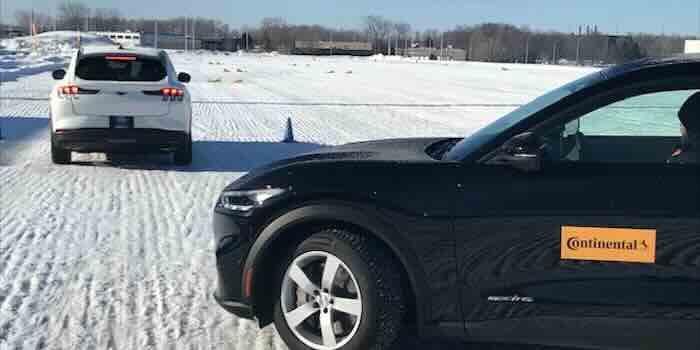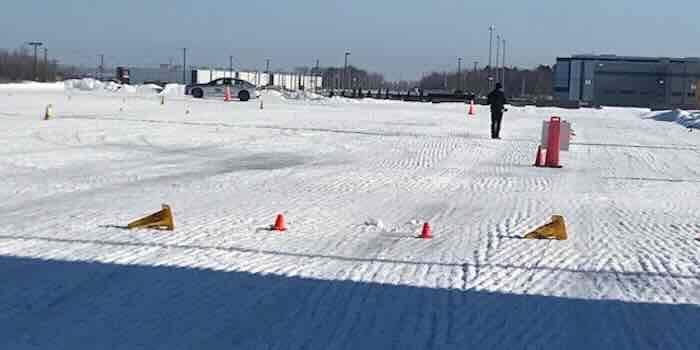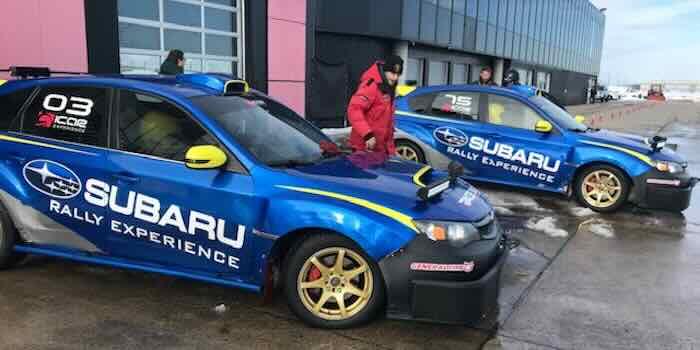By Jim Bray, CFP Automotive Editor ——Bio and Archives--March 9, 2024
Automotive | CFP Comments | Reader Friendly | Subscribe | Email Us

Tires are a very competitive business, with an abundance of brands
vying for your hard-earned dollars, so when you're introducing a new
model, it helps if you can get as much attention as possible.
To this end, Continental Tire, the European-based multinational
company that has been around for 150 years or so, threw a winter
driving bash at the ICAR facility at what used to be (and may still be,
for all I know) Canada's largest aviation white elephant, Mirabel
airport near Montreal.
The new tire, which will be available this autumn at Canadian Tire
outlets exclusively (though Continental also sells tires at just about
any such outlet you can imagine), is called the Ultimate Contact Winter
which the company says boasts "a directional tread pattern with
advanced
siping technology (that) ensures optimal grip on ice and snow by creating additional biting edges."
The Ultimate Contact Winters take advantage of what Continental calls "Polar Plus Technology", and they're also engineered with electric vehicles in mind, for those folks who heed the siren song of the eco-warriors. This means they offer low noise, as well as low rolling resistance for "improved efficiency and extended range" (if only they'd also recharge the EV's batteries to extend the range!). They also sport a special "EV" badge, to indicate their EV friendliness, as well as the winter tire "three peak mountain" logo, which Continental says means you get up to 10 per cent more traction on snow than a regular winter tire.
It isn't just the upcoming Ultimate Contact Winters that get the EV badge, however; the company says all of its products will be labelled as EV-friendly going forward.
Continental says the new tires' tread compound stays pliable in very cold temperatures (which is what you want, because by staying relatively soft they perform better than typical all-seasons do when Old Person Winter comes a-calling.
Good performance on ice is also really important for a winter tire – especially around here in Calgary, where the "City Parents" (can't call 'em City Fathers any more, can we?) routinely let the roads turn to skating rinks rather than actually contemplate snow removal. And to that end, Continental's Ice Grip technology features a Sipe concept that alternates in the center and intermediated blocks of the overall tread.

These varying sipe angles are said to be good for cornering (always a challenge on ice, as we'd find out in person at the launch event) thanks to their "higher driving/steering angle coverage." They also sport shoulder sipes of varying thicknesses, with "micro carvings" parallel to the sipes.
What the heck is a sipe? Well, according to the sometimes-reliable
Wikipedia, "Siping is a process of cutting thin slits across a rubber
surface to improve traction in wet or icy conditions." The idea as I
understand it is to enhance traction by adding more surface area to the
tread, which the siping accomplishes.
The ultimate contact patch is a flat, slick tire like you see on racing cars, but that isn't practical on road tires in the real world because slicks are designed to be used on dry asphalt and, once the dryness and/or asphalt gets wet or snowy, you might as well be driving a sled.
That's why racing cars hit the pits for treaded tires when the clouds open. And that's why commercial rain, snow – and even street – tires have treads, because they offer a workable compromise between ultimate traction on dry roads and terrible traction on wet/snowy roads. Naturally, the trick is in how you design the tread.
To demonstrate how the Ultimate Contact Winters work in "real world" conditions, Continental set up four demonstration areas where we could sample the new tires and compare them side by side with some of the competition. So, we had the Continentals going up against Bridgestones, Michelins and Goodyears, which is a pretty good cross section.
The first two sessions in which I participated saw us driving as quickly as we could through "handling courses" made up of a bunch of cones on an icy surface. There was some slaloming, some acceleration and some heavy braking, and then we'd switch from one vehicle to the next, which gave us a pretty nice apples to apples comparison of the tires' performance.
First up for me was trying them on Ford's Mach E "Mustang" EV SUV, then we moved on to Volvo S60's on a similarly slick but differently laid out course. The third head-to-head test was on a short "road course" in Toyota Corollas.

Not surprisingly, the Continentals outperformed the competition in each of these test scenarios (I'd have been surprised if this weren't the case, since the folks at Continental are certainly not fools!) but some comparisons were closer than others. The most notable comparison to me was the Toyota Corolla demo, which pitted the Continentals against Bridgestone Blizzaks, which is what my family runs currently on our Toyota RAV4 and Audi A4.
I've been very satisfied with the Blizzaks, but the Continentals very clearly kicked their butts. And doesn't that just figure?
The Continentals seemed better overall when the slick surface also included tight turns, offering more grip and better handling under such conditions. This, of course, is exactly what you want unless your goal is to do some fishtailing and/or donuting just for fun.
Support Canada Free Press

Continental also threw in a bonus session in which we were allowed to put on a racing helmet (I prefer to not call it a "crash" helmet for obvious reasons) and get behind the wheel of an honest to goodness Subaru rally car, on studded tires, for some madcap laps on a very icy track. We were taught to slide the rear end of the car out in a kind of "drifting-ish" move going into a corner, and we learned how to get it back under control again as well, which certainly helped!
We got five laps in the manual transmission-equipped Subarus (which, much to my embarrassment, I managed to stall twice right off the bat thanks to not being used to its heavy clutch) and they timed our last three, pitting all of the attendees against each other to post the fastest lap time. After my initial oafishness with the clutch, I didn't expect much success on my part.
Except I won, beating the third-place contender by about two seconds, if I remember correctly, and edging out second place by just shy of half a second.
It was an absolute blast! So, thanks to Continental for that opportunity!
The Ultimate Contact Winters are supposed to hit the market this coming August (which should be an august occasion, indeed!). Continental will offer them in sizes ranging from 15-20 inches, in T and H speed ratings. They come with an XL load range, too, so they should handle the extra bloat of EV's with their innumerable batteries.
Pricing hasn't been announced yet, but I imagine they'll be competitive (otherwise, what's the point?).
It was a very interesting and enjoyable demonstration of what appears to be an excellent new competitor in the winter tire market. Thanks again to Continental Tire for inviting me to the bash; I'm very impressed with the Ultimate Contact Winters and anticipate them flying off Canadian Tire store shelves later this year.
Copyright 2024 Jim Bray
TechnoFile.com
View Comments
Jim publishes TechnoFile Magazine. Jim is an affiliate with the Automobile Journalists Association of Canada and his careers have included journalist, technology retailer, video store pioneer, and syndicated columnist; he does a biweekly column on CBC Radio One’s The Business Network.
Jim can be reached at: bray@technofile.com